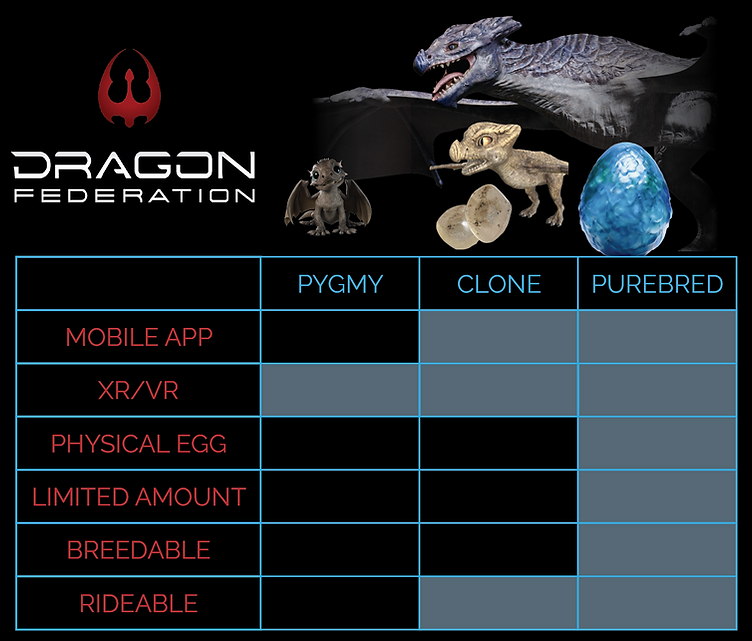
Cave Pygmy
Kollodryn
DRACONIDAE MINALAE MINIFUR KOLLODRYN
SPECS
Height: 12 centimeters (4.75 inches)
Length: 46 centimeters (18 inches)
Wingspan: 48 to 53 centimeters (19 to 21 inches)
Body type: Dragon
Skin type: Scaled
Limbs: 4 legs, 1 pair of wings
Locomotion: Quadrupedal, Aerial.
Diet: Insectivore, Opportunistic Carnivore.
Breeding: Pygmy dragons are not breedable
Mobile App Incubation: Pygmy dragons do not have a mobile app component.
Bond Difficulty: Easy
Difficulty:
Easy
Ridable?: No
Lifespan: Dragons live for many human generations. An exact timeframe has yet to be discovered. Dragon Federation is still researching these dragons and information regarding the full lifespan has yet to be discovered. Additional information must be gathered once your dragons have hatched to determine this timeline.
Activity Cycle: They're social sleepers and simply take their cues from the humans and dragons around them. When their humans go to sleep, they do.
Possible Classes:
Spitter
Climber
Habitat: Solution and talus caverns of the Dragon Realm
Colors:
Black
Blue
Brown
GENERAL OVERVIEW
Drawn from their subterranean caverns by their curiosity about the humans who’ve arrived in the Dragon Realm, cave pygmy dragons are small, quick, and very inquisitive. These small dragons have padded toes tipped with tiny claws that allow them to climb walls and ceilings much like geckos, and they have large eyes that aid in spotting the movements of other tiny cave dwellers. Cave pygmies are pursuit predators and will stalk and then pounce on their prey when an opportune moment appears. Immediately recognizing humans and their homes as new territory to conquer and explore, cave pygmies spare no effort in getting into every nook and cranny they can. It isn’t uncommon to find them hanging out on the walls or even on the ceiling of Riders’ homes. Cave pygmies seem to enjoy trying to surprise their human companions by hiding somewhere up and out of sight before suddenly dropping down to land on their Rider’s head. They will also sequester themselves away in frequently used cabinets and containers so that they can lunge out and surprise their Rider when the door or top is opened.
Native to solution and talus caves, these dragons are typically dark in color to blend in with shadows and crevices. Like most of the other pygmy species, these dragons have padded toes tipped with tiny claws that allow them to climb walls and ceilings much like geckos. Cave pygmies have large eyes adapted to the dark and lowlight conditions of their subterranean homes to aid in spotting the movements of other tiny cave dwellers, which the dragon will stalk until presented with the opportune moment to pounce. Pygmies have a set of finned ears that come off the backside of their head. Across these sensitive appendages are tiny sensory filaments, not unlike the microscopic hair that covers bat wings. At the base of each minuscule filament is a tactile receptor, and together receptors and filament inform the pygmy of changes in air current around them, aiding them both in hunting and in navigating the dark niches they call home. Along with picking up air fluctuations, these organs also contain lucifern and luciferase molecules that react when oxygen is diffused into the respective cells. This causes the ear fins to bioluminesce, producing a soft glow that is utilized in attracting prey. The cave pygmy’s spines also contain these molecules, which are linked into the bioluminescence system, so they also give off light alongside the fins. Because kollodryn’s wide eyes are accustomed to the low and nearly no light level of the caverns they call home, they have evolved a nictitating membrane to protect their vision when bioluminescing. The membrane covers the visible eye, darkening the entire oculus so as to cause the eyeball to appear completely black. This membrane does not interfere with the pygmy’s vision, and once the kollodryn ceases bioluminescing, the nictitating membrane pulls back from covering the eye.

EGGS
Dragon Federation is currently participating in ethological studies on this topic and will publish an update to the bestiary when more information has been acquired.
BEHAVIOR AND TEMPERAMENT
With an intelligence akin to birds and an insatiable need to get into things similar to cats, a Rider who has a pygmy as a companion will never be bored. Much like perpetual two year olds, pygmies explore every inch of their territory, and if they can sneak into, claw open, or squeeze through anything set up to dissuade them, they will hyperfocus on overcoming said barricade until they achieve their goals (or until a new challenge distracts them). These dragons also get bored very quickly. They can be entertained with toys and puzzles for some time, but the “newness” of an object can wear off rapidly. Building jungle gyms, providing a variety of toys, and chasing the pygmy around to wear out some of their excess energy can aid in regulating their mischievous nature.
The kollodryn is typically found to live solitarily or in small family groups – usually a mating pair and immature progeny. Once the hatchlings reach adulthood, they venture off on their own to find new territory and prey. Cave pygmies have an irregular activity cycle while living in caverns, often becoming synced up to whatever habits their mates or family units possess, but since being adopted by Riders, they tend to present with nocturnal behaviors. The kollodryn prefers dark and shadows, and excessive exposure to light can harm their vision.
DIET AND HABITAT
Cave pygmies are nominally classified as insectivores, as the majority of their diet is made up of millipedes, cockroaches, spiders, and pseudoscorpions, but they are opportunistic creatures. Bats, fish, mice, and any other creature small enough to be pounced upon and bitten can end up on the kollodryn’s menu. The pygmy’s diet varies greatly depending on what cave system they reside in and what native species make their territory home.
Cave pygmies are typically found in talus and solution caves. Talus caves are formed when boulders pile up on the slopes or at the bases of mountains, oftentimes as a result of tectonic shifts or by long-term weathering and erosion of cliff faces or mountain domes. Solution caves are formed by water slowly seeping through rock and dissolving over long periods of time. Given the broad regions these formations can occur within, the cave pygmy is one of the most wide-ranging species both in territory and elevation – talus caves can be found up to 690 meters above sea level (2,264 feet), and solution caves have been known to descend as far as 1,000 meters below sea level (3,280 feet).
CLONED
Pygmy dragons have not successfully been cloned.
THREATS
Dragon Federation is currently participating in ethological studies on this topic and will publish an update to the bestiary when more information has been acquired.
CARE
More information will be posted once dragon federation has completed more research.











